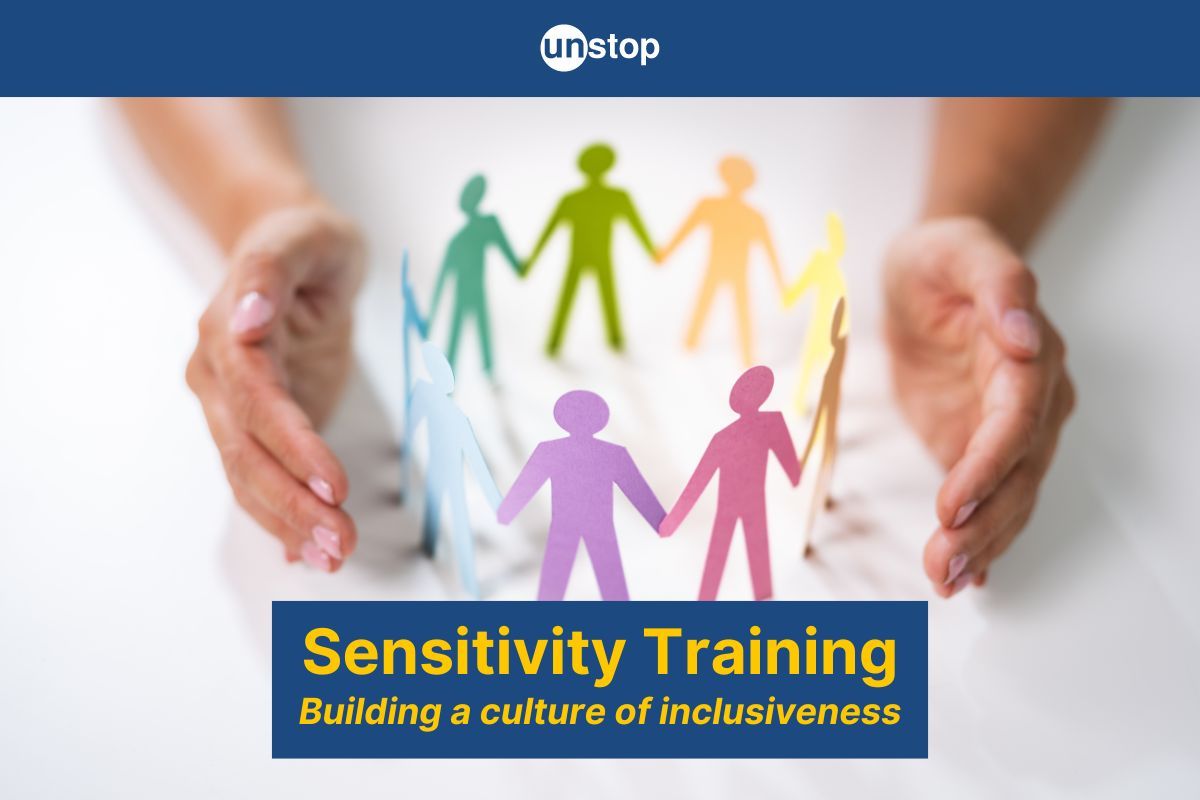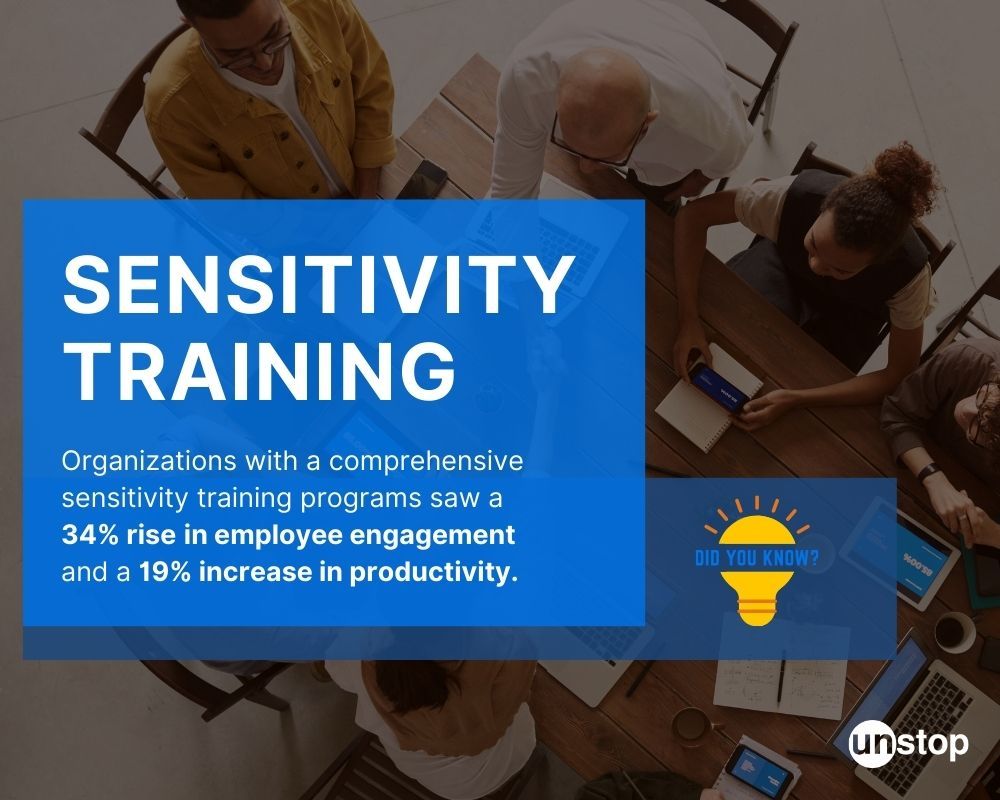- What is Sensitivity Training?
- Importance of Sensitivity Training
- Objectives of Sensitivity Training
- Types of Sensitivity Training
- Steps to Implement Sensitivity Training
- Sensitivity Training: Best Practices
- Closing Thoughts
- Frequently Asked Questions
Sensitivity Training: Importance, Objectives & Process

Sensitivity training is essential in today’s diverse workplace. It helps teams understand and respect differences, fostering a more inclusive environment. By addressing biases and promoting empathy, sensitivity training equips employees with tools to communicate effectively, improving collaboration and boosting productivity.
Investing in sensitivity training enhances individual growth and strengthens team dynamics. Let's explore the concept, its importance, and the process further.
What is Sensitivity Training?
Definition
Sensitivity training is a program aimed at improving interpersonal dynamics in diverse workplaces. It is a form of education and awareness program designed to enhance individuals' empathy, understanding, and respect for diverse perspectives.
It focuses on educating employees about social sensitivity and the impact of their actions with an aim to create a more inclusive and harmonious environment by addressing biases, stereotypes, and prejudices.
Through group discussions, role-playing, and other interactive activities, participants develop a deeper awareness of their own behaviors and their impact on others.
Impact on Work Culture & Employees
Sensitivity training plays a crucial role in fostering an inclusive culture. It values different perspectives and encourages respect among team members.
By participating in a sensitivity program, employees understand the importance of diversity. They learn to appreciate varying backgrounds and experiences. More importantly, they learn to recognize behaviors (words and actions) that may offend others. This awareness helps mitigate negative behaviors.
Regular sensitivity training also helps create a safe environment for all employees. Companies that invest in corporate sensitivity training show commitment to employee well-being.
Importance of Sensitivity Training

Workplace Harmony
Sensitivity training plays a crucial role in fostering a respectful workplace environment. It helps employees understand and address sensitive issues. This understanding reduces the chances of conflicts arising from misunderstandings.
Conflict Reduction
Training sessions focus on communication skills and empathy. Participants learn to recognize their biases and how these affect others. This awareness is vital for minimizing disputes among team members. Employees who feel understood are less likely to escalate conflicts.
Read in-depth about conflict resolution strategies that help foster a positive work environment.
Long-Term Benefits
The long-term benefits of sensitivity training include improved employee morale. Happy employees tend to be more productive, which benefits the entire organization.
A supportive atmosphere also boosts job satisfaction. Organizations that prioritize sensitivity training often see lower turnover rates. Employees stay longer when they feel valued and included. This stability enhances collaboration and innovation within teams.
Objectives of Sensitivity Training
Improve Communication
Sensitivity training aims to enhance interpersonal relationships. Improved communication skills are vital for effective teamwork. Employees learn to express themselves clearly and listen actively, leading to fewer misunderstandings and conflicts. Clear communication builds trust among team members.
Increase Awareness
Another goal is to increase awareness of personal biases. Many people hold unconscious biases that affect their interactions. Sensitivity training helps individuals recognize these biases. Understanding how different workplace biases impact others fosters a more inclusive environment. Employees become more mindful of their words and actions.
Foster Empathy
The intention is to foster a culture of empathy and understanding. Empathy allows employees to see things from others' perspectives. This understanding creates a supportive workplace atmosphere. When employees feel valued, they are more engaged and productive. A culture of empathy leads to stronger connections among coworkers.
Sensitivity training provides tools for navigating diverse work environments. It prepares employees to handle sensitive topics respectfully. The focus on empathy encourages collaboration and innovation.
Types of Sensitivity Training
Sensitivity training encompasses a wide range of programs designed to foster understanding and respect. Here are some common types:
Based on Participant Demographics
- Intergroup Sensitivity Training: Brings together individuals from different social groups (e.g., race, gender, age) to promote understanding and empathy.
- In-group Sensitivity Training: Focuses on building cohesion and collaboration within a specific group (e.g., a department or team).
Based on Training Focus
- Cultural Sensitivity Training: Emphasizes understanding different cultures, customs, and values.
- Gender Sensitivity Training: Addresses gender equality, stereotypes, and biases.
- Disability Sensitivity Training: Promotes awareness and acceptance of individuals with disabilities.
- Age Sensitivity Training: Focuses on understanding the needs and challenges of different age groups.
- Unconscious Bias Training: Helps participants recognize and address unconscious biases.
Based on Training Methodology
- T-Groups (Training Groups): Small, unstructured groups where participants learn through interaction and feedback.
- Encounter Groups: Similar to T-groups but with a stronger emphasis on personal growth and self-discovery.
- Laboratory Training: Focuses on interpersonal skills and group dynamics through structured exercises and simulations.
Remember: It's important to note that these categories often overlap, and many training programs incorporate elements from multiple types.
Steps to Implement Sensitivity Training

Effective sensitivity training requires careful planning and execution. Here are the key steps involved:
1. Assess Needs and Set Goals
- Evaluate the current workplace environment and identify specific areas where sensitivity training is needed.
- Set clear, measurable goals for what the training aims to achieve, such as reducing workplace conflicts or improving communication.
2. Select Training Methodology & Facilitators
- Choose appropriate training methods based on the target audience and training objectives (e.g., workshops, online modules, role-playing).
- Select experienced and skilled facilitators who can create a safe and inclusive learning environment. Ensure trainers have a good understanding of your organization's culture and specific needs
3. Develop Training Content
- Create engaging and relevant training materials that address specific diversity and inclusion issues (e.g. cultural awareness, unconscious bias, respectful communication, and conflict resolution.)
- Incorporate real-life examples, case studies, interactive activities, and role-playing exercises to engage participants.
4. Implement Training
- Timing & Frequency: Organize training sessions at times that are convenient for all employees. Consider offering multiple sessions to accommodate different schedules and ensure maximum participation.
- Setting: Conduct training sessions in a supportive and interactive atmosphere. Encourage open dialogue and participation.
- Method: Begin with an introduction that explains the purpose of the training and sets the tone for a respectful and open-minded session. Use a variety of training methods, including lectures, discussions, group activities, and multimedia presentations, to cater to different learning styles.
5. Gather Feedback
- Evaluate the effectiveness of the training through surveys, post-training assessments, and behavioral observations.
- Collect feedback from participants to gather insights on what worked well and what could be improved.
6. Reinforcement and Follow-up
- Reinforce the training by incorporating follow-up activities such as workshops, discussion groups, or regular check-ins.
- Provide ongoing support and resources to help employees apply what they have learned in their daily interactions.
7. Monitor and Measure Impact
- Track key metrics to measure the impact of sensitivity training on the workplace environment.
- Regularly review and update the training program to ensure it remains relevant and effective in promoting a respectful and inclusive workplace.
By following these steps, organizations can implement effective sensitivity training programs that promote a more inclusive and respectful workplace.
Sensitivity Training: Best Practices
Create Safe Space
Encouraging participants to engage openly is vital. A safe space allows individuals to express their thoughts without fear. This openness fosters trust and honesty among team members. Sharing personal experiences can deepen understanding of different perspectives.
Establish Ground Rules
Establishing ground rules is essential for effective training. These rules should promote respect and non-judgment during discussions. Clear guidelines help participants feel secure in sharing their views.
For example, rules might include listening without interrupting or avoiding personal attacks. This structure supports a positive environment.
Utilize Role-Playing
Utilizing role-playing can enhance learning outcomes. Real-life scenarios allow individuals to practice their responses in a controlled setting. Participants can step into different roles to better understand various viewpoints. This method encourages reflection on personal behavior and its impact on others.
Reflect on Behavior
After each activity, reflection is key. Encourage participants to think about what they learned from the role-playing exercises and discuss how their feelings changed as they stepped into someone else's shoes. This process helps solidify the lessons learned during sensitivity training.
Keep it Ongoing
Sensitivity training aims to develop emotional intelligence and boost self-awareness among employees. This allows employees to create a more collaborative workforce, be better decision-makers, and effectively navigate workplace diversity.
However, it’s important to remember that the journey does not end with initial training. Ongoing reflection is essential for personal growth after sensitivity training. Regular feedback sessions help employees evaluate their progress and encourage them to apply counselling methods learned during training in real-life situations. Sustaining this development prevents a return to old habits, reducing the risk of a hostile work environment.
Closing Thoughts
Sensitivity training is vital for creating a respectful workplace. it improves employee well-being and self-awareness and helps coworkers understand diverse perspectives, enhancing communication and collaboration.
By implementing effective sensitivity training, you foster an inclusive environment where everyone feels valued and understood. This boosts morale and productivity, making your organization thrive.
Frequently Asked Questions
1. What is sensitivity training?
Sensitivity training is a program designed to help individuals understand and respect diverse perspectives, fostering an inclusive workplace. It encourages empathy and enhances interpersonal skills.
2. Why is sensitivity training important?
Sensitivity training promotes a positive work environment by reducing conflicts and misunderstandings. It helps employees appreciate diversity, leading to improved teamwork and productivity.
3. What are the objectives of sensitivity training?
The main objectives include increasing awareness of biases, enhancing communication skills, and promoting inclusivity. These goals aim to create a more harmonious workplace culture.
4. How can organizations implement sensitivity training?
Organizations can implement sensitivity training through workshops, seminars, or online courses. Engaging qualified trainers ensures effective delivery and relevant content tailored to the workforce.
5. Who should participate in sensitivity training?
All employees, from entry-level staff to executives, should participate. This collective effort fosters a unified approach towards understanding and respecting diversity within the organization.
6. How does sensitivity training enhance employee well-being?
By promoting understanding and acceptance, sensitivity training reduces stress and anxiety related to workplace interactions. Employees feel valued and supported, improving overall job satisfaction.
7. Is sensitivity training a one-time event?
No, sensitivity training should be an ongoing process. Regular refreshers and new sessions help reinforce learning and adapt to evolving workplace dynamics, ensuring sustained effectiveness.
Suggested Reads:
- Job Enlargement: Definition, Benefits, And Implementation Process
- Golden Handcuffs: Definition, Purpose, Types And Real-World Examples
- HR Guide To Employee Sabbatical Leave: Pros, Cons & Key Considerations
- What Are Technical Tests & Why Are They Popular Among Recruiters?
- Prioritizing Employee Mental Health - A Guide For HR Professionals
I’m a reader first and a writer second, constantly diving into the world of content. If I’m not writing or reading, I like watching movies and dreaming of a life by the beach.
Login to continue reading
And access exclusive content, personalized recommendations, and career-boosting opportunities.
Subscribe
to our newsletter
Blogs you need to hog!

Organize Hackathons: The Ultimate Playbook With Past Case Studies

What is Campus Recruitment? How To Tap The Untapped Talent?

Lateral Hiring: A Complete Guide To The Process, Its Benefits, Challenges & Best Practices













Comments
Add comment